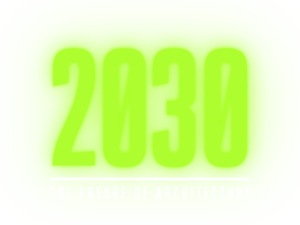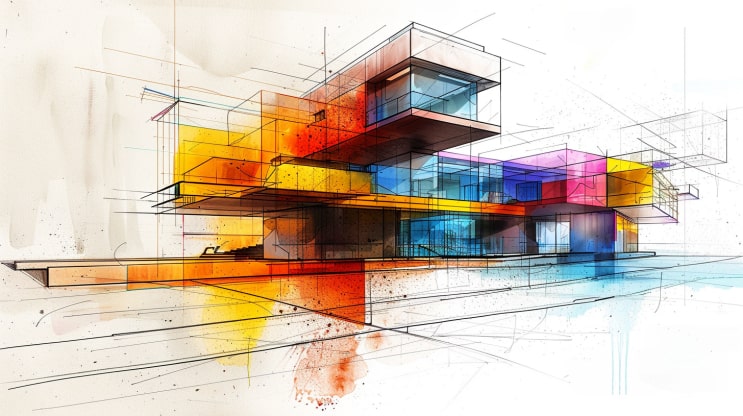
A FREE COURSE TO THE FOREFRONT OF ARCHITECTURE INNOVATION
A FUSION OF SUSTAINABLE DESIGN, HIGH-PERFORMANCE BUILDINGS, AND ARTIFICIAL INTELLIGENCE
JULY 8TH TO 12TH, 2024
ONLINE AND FREE EVENT
JULY 8TH TO 12TH, 2024
ONLINE AND FREE EVENT
By clicking the button, you agree to our Terms of Use and Privacy Policy, including the use of cookies and the sending of communications.
Neuroarchitecture merges the fields of neuroscience and architecture, focusing on how built environments can affect our emotions, behaviors, and overall well-being. This interdisciplinary approach seeks to understand the complex interactions between spatial design and the human brain, aiming to create spaces that enhance mental health, productivity, and social connections.
By studying the impacts of architectural elements such as light, space, and materials on human neurology, neuroarchitecture offers insights into designing more effective, harmonious, and human-centric environments. The historical evolution of neuroarchitecture shows a growing recognition of the importance of psychological and physiological considerations in architectural design, marking a shift from purely aesthetic or functional approaches to more holistic, human-focused strategies.
The Science Behind Neuroarchitecture
At the core of neuroarchitecture is the study of how our brains and bodies respond to different environments. Research in this field leverages neuroscientific methods, such as brain imaging and physiological monitoring, to analyze the effects of architectural designs on cognitive functions, emotional states, and stress levels. Key principles include the impact of natural light on circadian rhythms, the influence of room layouts on social interactions, and the effects of colors and textures on mood and cognitive performance.
Understanding these principles allows architects and designers to create spaces that actively contribute to users’ mental and physical health, fostering environments that are not only functional but also nurturing and restorative.
Benefits of Neuroarchitecture
The application of neuroarchitectural principles offers numerous benefits across various settings, from healthcare facilities to educational institutions, workplaces, and residential environments. By designing spaces that align with human neurological and psychological needs, neuroarchitecture can significantly enhance mental well-being, reducing stress and anxiety levels. In healthcare settings, for example, neuro architectural designs can accelerate patient recovery by creating calming and comfortable environments.
In educational spaces, thoughtful design can improve concentration and learning outcomes, while in the workplace, neuroarchitecture can boost productivity and creativity by optimizing lighting, acoustics, and spatial layouts. These benefits underscore the potential of neuroarchitecture to transform our built environments into places that support and enhance human life at every level.


Neuroarchitecture in Healthcare
The healthcare sector stands as a primary beneficiary of neuroarchitectural principles, with evidence suggesting that well-designed hospital environments can significantly affect patient recovery rates, stress reduction, and overall satisfaction. Neuroarchitecture in healthcare focuses on creating healing environments that support the physical and emotional needs of patients, as well as the functional requirements of medical staff. This involves careful consideration of natural light, noise control, privacy, and the use of natural elements and colors to promote a sense of calm and well-being.
Designing Healing Environments: Case Studies from Hospitals and Clinics
Research has shown that patients in rooms with ample natural light experience shorter hospital stays, require less pain medication, and report better satisfaction with their care. For instance, the design of Maggie’s Cancer Centre in various locations utilizes principles of neuroarchitecture by incorporating large windows, private garden views, and interior spaces that promote social interaction among patients and staff, thereby enhancing the healing process. Similarly, the use of nature-inspired elements, such as indoor gardens and water features, in the Cleveland Clinic and Johns Hopkins Hospital, has been linked to reduced stress levels in patients and visitors alike.
The Impact of Spatial Design on Patient Recovery Rates
Spatial design plays a crucial role in patient recovery. The layout of patient rooms, the orientation of beds towards windows, and the inclusion of artwork and elements of nature not only improve the aesthetic appeal of a healthcare setting but also contribute to the emotional and psychological well-being of patients.
Studies indicate that patients with a view of nature from their hospital beds tend to recover faster from surgery and infections, showing the profound impact of visual elements on health outcomes. Furthermore, the design of communal spaces within healthcare facilities, such as lounges and cafeterias, encourages social interactions that are vital for mental health, especially in long-term care settings.
The integration of neuroarchitecture in healthcare settings underscores a shift towards patient-centered design, where the focus extends beyond medical treatment to encompass the holistic well-being of patients. This approach not only enhances the healing environment but also contributes to the efficiency and satisfaction of healthcare providers, ultimately leading to better health outcomes and improved healthcare experiences.
By leveraging the insights from neuroscientific research, architects and designers have the opportunity to revolutionize healthcare environments, making them more conducive to healing, comfort, and human connection.
Educational Spaces and Neuroarchitecture
Neuroarchitecture’s application extends into the realm of educational spaces, where the design of classrooms, libraries, and common areas can significantly influence learning outcomes, concentration levels, and overall student well-being. By creating environments that cater to the neurobiological needs of learners, educational facilities can become more conducive to engagement, retention, and creativity.
How Neuroarchitecture Can Optimize Learning and Concentration
- Lighting: Natural light has been shown to improve mood and energy, significantly impacting students’ concentration and performance. Studies suggest that classrooms with ample natural lighting can boost test scores and reduce fatigue.
- Color Psychology: Specific colors can enhance cognitive functions and emotional well-being. For example, blue hues are known to foster calmness and focus, whereas green can stimulate creativity and relaxation.
- Spatial Layout: Flexible learning spaces that allow for various teaching methods and group sizes can encourage collaboration and active learning. The arrangement of furniture and the availability of different zones (e.g., quiet reading areas, group workspaces) can support diverse learning styles and activities.
- Acoustic Design: Proper sound management ensures that classrooms provide a conducive learning environment. Minimizing external noise and controlling indoor acoustics can significantly reduce distractions and enhance students’ ability to focus.
Case Studies of Neuroarchitecturally Designed Schools
- The Green School, Bali: Utilizes natural materials and an open-air classroom design to foster a connection with nature, enhancing students’ well-being and engagement with the learning material.
- Copenhagen’s Kids’ City: Features varied learning environments, including spaces for quiet reflection and active play, demonstrating the importance of diverse spatial experiences in stimulating learning and development.
Workplace Design and Neuroarchitecture
The design of workplace environments plays a pivotal role in employee productivity, satisfaction, and overall company performance. Neuroarchitecture offers insights into creating office spaces that not only meet functional requirements but also promote mental health and creativity.
Creating Office Spaces that Boost Performance and Reduce Stress
- Ergonomic Design: Furniture and workstations designed with human physiology in mind can reduce physical strain and enhance comfort, leading to increased productivity and reduced absenteeism.
- Biophilic Elements: Incorporating plants, water features, and views of nature into office design can lower stress levels, improve mood, and increase focus and creativity among employees.
- Variety of Workspaces: Providing a range of workspaces, including areas for collaboration, private focus rooms, and relaxation zones, can accommodate different tasks and working styles, fostering a more dynamic and productive work environment.
The Future of Neuro architectural Office Design Post-Pandemic
The COVID-19 pandemic has reshaped expectations and requirements for office spaces, emphasizing the need for flexibility, health, and well-being. Future office designs may include:
- Enhanced Ventilation Systems: Improving air quality and reducing the risk of airborne diseases.
- Touchless Technology: Minimizing contact with surfaces to enhance hygiene and safety.
- Flexible Layouts: Allowing for social distancing and adaptable use of space as needs evolve.
Key Neuroarchitecture Principles and Their Applications
| Principle | Application | Benefits |
|---|---|---|
| Natural Light | Classrooms, Offices, Hospitals | Improves mood, energy, concentration, and recovery |
| Color Psychology | Educational Spaces, Workplaces | Enhances cognitive function and emotional well-being |
| Spatial Layout | Schools, Offices | Supports diverse learning styles and work activities |
| Biophilic Design | All Environments | Reduces stress, boosts creativity and focus |
| Ergonomic Furniture | Workplaces, Educational Facilities | Reduces physical strain, enhances comfort and productivity |
The integration of neuroarchitecture across various environments not only enhances the functionality of these spaces but also significantly improves the quality of life for their occupants. By understanding and applying principles derived from neuroscience, architects, and designers have the power to transform our daily environments into spaces that truly support and enhance human well-being and performance.
Conclusion: Summarizing the Transformative Power of Neuroarchitecture
Neuroarchitecture bridges neuroscience and architecture to create spaces that enhance well-being, productivity, and learning. This interdisciplinary approach applies principles such as natural light, color psychology, and biophilic design to foster environments that support psychological and physiological health. From healthcare and educational settings to workplaces and public spaces, neuroarchitecture demonstrates its versatility and impact on human life.
It emphasizes the importance of designing with human needs at the forefront, promising a future where built environments nurture both mind and body. As we move forward, the integration of scientific insights into architectural practices holds the key to transforming our living and working spaces into holistic, human-centric environments.
If you want to learn about our courses and consultancies in Portuguese language, click here.



A FREE COURSE TO THE FOREFRONT OF ARCHITECTURE INNOVATION
A FUSION OF SUSTAINABLE DESIGN, HIGH-PERFORMANCE BUILDINGS, AND ARTIFICIAL INTELLIGENCE
JULY 8TH TO 12TH, 2024
ONLINE AND FREE EVENT
JULY 8TH TO 12TH, 2024
ONLINE AND FREE EVENT
By clicking the button, you agree to our Terms of Use and Privacy Policy, including the use of cookies and the sending of communications.
